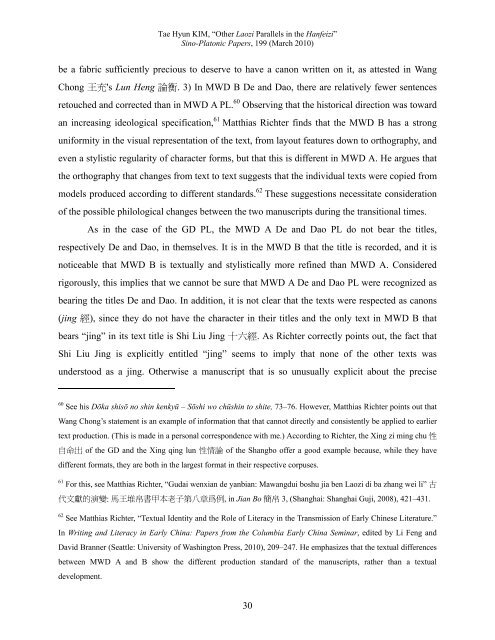Other Laozi Parallels in the Hanfeizi - Sino-Platonic Papers
Other Laozi Parallels in the Hanfeizi - Sino-Platonic Papers
Other Laozi Parallels in the Hanfeizi - Sino-Platonic Papers
You also want an ePaper? Increase the reach of your titles
YUMPU automatically turns print PDFs into web optimized ePapers that Google loves.
Tae Hyun KIM, “<strong>O<strong>the</strong>r</strong> <strong>Laozi</strong> <strong>Parallels</strong> <strong>in</strong> <strong>the</strong> <strong>Hanfeizi</strong>”<br />
S<strong>in</strong>o-<strong>Platonic</strong> <strong>Papers</strong>, 199 (March 2010)<br />
be a fabric sufficiently precious to deserve to have a canon written on it, as attested <strong>in</strong> Wang<br />
Chong 王充's Lun Heng 論衡. 3) In MWD B De and Dao, <strong>the</strong>re are relatively fewer sentences<br />
retouched and corrected than <strong>in</strong> MWD A PL. 60 Observ<strong>in</strong>g that <strong>the</strong> historical direction was toward<br />
an <strong>in</strong>creas<strong>in</strong>g ideological specification, 61 Matthias Richter f<strong>in</strong>ds that <strong>the</strong> MWD B has a strong<br />
uniformity <strong>in</strong> <strong>the</strong> visual representation of <strong>the</strong> text, from layout features down to orthography, and<br />
even a stylistic regularity of character forms, but that this is different <strong>in</strong> MWD A. He argues that<br />
<strong>the</strong> orthography that changes from text to text suggests that <strong>the</strong> <strong>in</strong>dividual texts were copied from<br />
models produced accord<strong>in</strong>g to different standards. 62 These suggestions necessitate consideration<br />
of <strong>the</strong> possible philological changes between <strong>the</strong> two manuscripts dur<strong>in</strong>g <strong>the</strong> transitional times.<br />
As <strong>in</strong> <strong>the</strong> case of <strong>the</strong> GD PL, <strong>the</strong> MWD A De and Dao PL do not bear <strong>the</strong> titles,<br />
respectively De and Dao, <strong>in</strong> <strong>the</strong>mselves. It is <strong>in</strong> <strong>the</strong> MWD B that <strong>the</strong> title is recorded, and it is<br />
noticeable that MWD B is textually and stylistically more ref<strong>in</strong>ed than MWD A. Considered<br />
rigorously, this implies that we cannot be sure that MWD A De and Dao PL were recognized as<br />
bear<strong>in</strong>g <strong>the</strong> titles De and Dao. In addition, it is not clear that <strong>the</strong> texts were respected as canons<br />
(j<strong>in</strong>g 經), s<strong>in</strong>ce <strong>the</strong>y do not have <strong>the</strong> character <strong>in</strong> <strong>the</strong>ir titles and <strong>the</strong> only text <strong>in</strong> MWD B that<br />
bears “j<strong>in</strong>g” <strong>in</strong> its text title is Shi Liu J<strong>in</strong>g 十六經. As Richter correctly po<strong>in</strong>ts out, <strong>the</strong> fact that<br />
Shi Liu J<strong>in</strong>g is explicitly entitled “j<strong>in</strong>g” seems to imply that none of <strong>the</strong> o<strong>the</strong>r texts was<br />
understood as a j<strong>in</strong>g. <strong>O<strong>the</strong>r</strong>wise a manuscript that is so unusually explicit about <strong>the</strong> precise<br />
60<br />
See his Dōka shisō no sh<strong>in</strong> kenkyū – Sōshi wo chūsh<strong>in</strong> to shite, 73–76. However, Matthias Richter po<strong>in</strong>ts out that<br />
Wang Chong’s statement is an example of <strong>in</strong>formation that that cannot directly and consistently be applied to earlier<br />
text production. (This is made <strong>in</strong> a personal correspondence with me.) Accord<strong>in</strong>g to Richter, <strong>the</strong> X<strong>in</strong>g zi m<strong>in</strong>g chu 性<br />
自命出 of <strong>the</strong> GD and <strong>the</strong> X<strong>in</strong>g q<strong>in</strong>g lun 性情論 of <strong>the</strong> Shangbo offer a good example because, while <strong>the</strong>y have<br />
different formats, <strong>the</strong>y are both <strong>in</strong> <strong>the</strong> largest format <strong>in</strong> <strong>the</strong>ir respective corpuses.<br />
61<br />
For this, see Matthias Richter, “Gudai wenxian de yanbian: Mawangdui boshu jia ben <strong>Laozi</strong> di ba zhang wei li” 古<br />
代文獻的演變: 馬王堆帛書甲本老子第八章爲例, <strong>in</strong> Jian Bo 簡帛 3, (Shanghai: Shanghai Guji, 2008), 421–431.<br />
62<br />
See Matthias Richter, “Textual Identity and <strong>the</strong> Role of Literacy <strong>in</strong> <strong>the</strong> Transmission of Early Ch<strong>in</strong>ese Literature.”<br />
In Writ<strong>in</strong>g and Literacy <strong>in</strong> Early Ch<strong>in</strong>a: <strong>Papers</strong> from <strong>the</strong> Columbia Early Ch<strong>in</strong>a Sem<strong>in</strong>ar, edited by Li Feng and<br />
David Branner (Seattle: University of Wash<strong>in</strong>gton Press, 2010), 209–247. He emphasizes that <strong>the</strong> textual differences<br />
between MWD A and B show <strong>the</strong> different production standard of <strong>the</strong> manuscripts, ra<strong>the</strong>r than a textual<br />
development.<br />
30
















